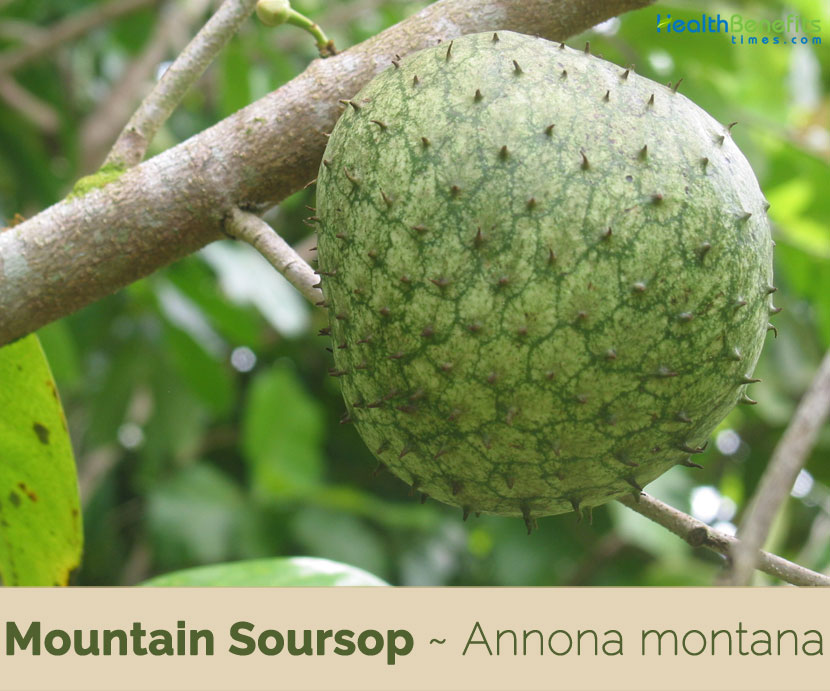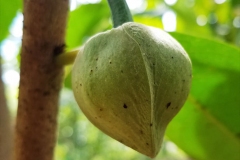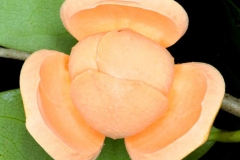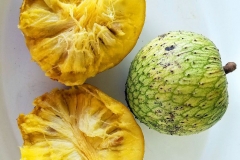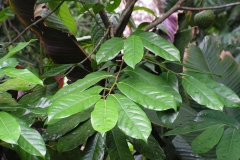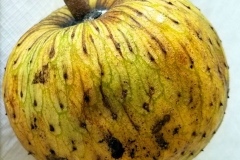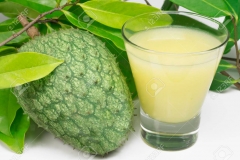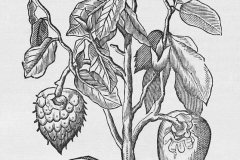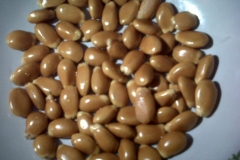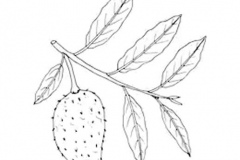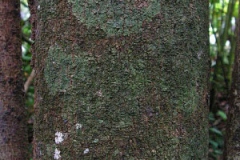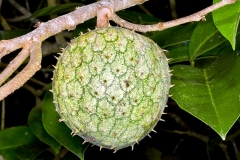The name of the genus comes from the Latin word Annona which means aliment, foodstuff, with reference to the alimentary utilization of the fruits, after others, from the local name. The name of the species comes from the Latin word montanus related to mountains, mountain, with obvious signification, even if, actually, the plant grows up mostly at low altitudes (0-600 m).
Mountain soursop has several traditional medicinal uses in South American and the Caribbean. Fruit, seeds, bark, leaves, and roots have all been used to treat intestinal parasites, coughs (including asthma and bronchitis), inflammation, diabetes, and hypertension. Research on extracts has recognized antiviral, anti-parasitic, anti-rheumatic, anti-inflammatory, and anti-hyperglycemic properties. It has also been used as an anti-depressant and at least one study has found it effective against multi-drug resistant cancer cells.
Mountain Soursop Facts
| Mountain Soursop Quick Facts | |
|---|---|
| Name: | Mountain Soursop |
| Scientific Name: | Annona montana |
| Origin | South America, Central America and West Indi |
| Colors | Green turning yellow when ripe |
| Shapes | Nearly round or broad-ovoid, about 15 cm (5.9 inches) long and 7–13 cm wide |
| Flesh colors | Yellow |
| Taste | Bitter or sour |
| Health benefits | Beneficial for intestinal parasites, coughs, asthma, bronchitis, inflammation, diabetes, hypertension, fever, headache |
| Name | Mountain Soursop |
|---|---|
| Scientific Name | Annona montana |
| Native | South America, Central America and West Indies – Bolivia, Brazil, Colombia, Costa Rica, Cuba, Dominican Republic, Ecuador, Guadeloupe, Jamaica, Panama, Paraguay, Peru, Puerto Rico, Suriname, Venezuela, the Amazon, and islands in the Caribbean |
| Common Names | Mountain Soursop, Wild Custard Apple, Wild Soursop, mountain sop, Fairchild’s annona |
| Name in Other Languages | Brazil: Araticú, Araticunzeiro Cashinahua: Araxiku’y Chinese: Shan Ci Fan Li Zhi (山刺番荔枝) Cuba: Guanábana Cimarrona, Guanábana De Lama Czech: Láhevník Horský Dominican Republic: Guanábana Cimarrona Dutch: Boszuurzak, Bosch-zuurzak English: Mountain soursop, Wild soursop, mountain sop, Fairchild’s annona French: Corossolier Bâtard, Cachiman Morveux, Cachiman Montage, Corossol Zombie, Corossolier Bâtard, Kachiman Montan French Guiana: Busi Atuku, Corossolier Sauvage, Manigl German: Schleimapfel, Schleim-Apfelbaum Guarani: Araticu Guayana: Busi Atuku, Corossolier Sauvage, Manigl Haiti: Corossol Zombie, Kowosol Zombie Honduras: Anona, Anona Cimarrona, Anone Hungarian: Hegyi annóna Japanese: Yama Toge Banreishi (ヤマトゲバンレイシ) Martinique: Kachiman Montan Persian: Anuna mawntana (آنونا مونتانا) Peru: Chirimoya, Guanabana, Guanábana, Guanábano Sirimbo, Huanabana Philippines: Ponhe Polish: Flaszowiec górski Portuguese: Araticum, Araticum Açú, Araticum Apé, Jaca de pobre, Araticum de paca, Araticum-ponhe, Araticú, Araticunzeiro Slovak: Anona Spanish: Guanábana De Monte, Cimarrón, Guanábana Cimarrona, Guanábana De Perro, Guanábana De Lama, Guanábana De Las Montañas, Taragus, Turagua Suriname: Boszuurzak (Dutch), Busi Atuku, Manigl Venezuela: Guanábana, Guanábana Cimarrona, Guanábana De Perro, Guanábana Brasileiro, Guanobano Cimarrón, Catuche Cimarron, Turagua |
| Plant Growth Habit | Evergreen or semi-evergreen deciduous shrub or tree |
| Growing Climates | Drought tolerant and will grow well in dry conditions but cannot withstand prolonged water-logging |
| Soil | Tolerant of a wide range of well-drained, fertile soils, but prefers a moist, sandy loam |
| Plant Size | 3 – 14 meters tall |
| Leaf | Alternate, distichous, short petiolate, oblong or elliptic 7–18 cm long by 2.5–8 cm wide, with tapering apex and rounded base, leathery, dark green above and pale green beneath, glabrous and glossy |
| Flower | Solitary or in pairs in older twigs, with stout peduncle. Sepals three, broad and pubescent; petals 6 in two whorls, inner three rounded; stamens numerous and crowded in rounded mass |
| Fruit Shape & Size | Nearly round or broad-ovoid, about 15 cm (5.9 inches) long and 7–13 cm wide |
| Fruit Color | Green turning yellow when ripe and covered with soft, 4 mm long spines |
| Flesh Color | Yellow |
| Seed | Light-brown, oblong plump seeds about 18 mm long |
| Propagation | By seed |
| Taste | Bitter or sour |
| Plant Parts Used | Leaves, bark, roots, seeds |
| Precautions |
|
Description
Mountain soursop is an evergreen or semi-evergreen deciduous shrub or small tree that normally grows about 3 – 14 meters tall. The tree slightly resembles that of the soursop but has a more spreading crown and very glossy leaves. It is slightly hardier and bears more or less continuously. The plant is drought tolerant and will grow well in dry conditions but cannot withstand prolonged water-logging. The plant is tolerant of a wide range of well-drained, fertile soils, but prefers a moist, sandy loam. It is harder than many other tropical fruit trees, capable of tolerating temperatures below freezing for brief periods.
Leaves
Leaves are alternate, distichous, short petiolate, oblong or elliptic 7–18 cm long by 2.5–8 cm wide, with tapering apex and rounded base, leathery, dark green above and pale green beneath, glabrous and glossy.
Flowers
Flowers are solitary or in pairs in older twigs, with stout peduncle. Sepals are three, broad and pubescent; petals 6 in two whorls, inner three are rounded; stamens numerous and crowded in rounded mass.
Fruits are nearly round or broad-ovoid, about 15 cm (5.9 inches) long and 7–13 cm wide. Its dark-green skin is studded with numerous short, fleshy spines and dark brown hairs. Fruits are initially green turning to yellow and very soft when ripe and fall down. Fruits have a yellow, fibrous flesh that is aromatic, sour to bitter, and contains many light-brown, oblong plump seeds about 18 mm long. Fruits are considered inferior to the soursop, so although it is occasionally cultivated, commercial production is not frequent.
The fruit of mountain soursop is edible but many people consider it tasteless, although some varieties produce better quality fruits. It has bitter or sour flesh but it is otherwise similar to the normal soursop, better known as the guanabana. Mountain soursop trees bear fruit more or less continuously starting two to three years after planting.
Traditional uses and benefits of Mountain Soursop
- Decoction of the leaves is drunk in the evening before retiring for its calming effect on the nerves and sedative effect which promotes sleep.
- Leaves are also used to treat fever and headache.
- Fruit, seeds, bark, leaves, and roots have all been used to treat intestinal parasites, coughs (including asthma and bronchitis), inflammation, diabetes, and hypertension, among many uses.
- Research on extracts has documented antiviral, anti-parasitic, anti-rheumatic, anti-inflammatory, and anti-hyperglycemic properties.
- It has also been used as an anti-depressant.
- An infusion of the leaves have some pain-relieving qualities for pregnant women.
- The mountain soursop plant is known to kill cancer cells due to compounds found mostly in the bark and the leaves.
- Fevers and head pain can be relieved using the plant’s leaves.
Culinary Uses
- Yellow, aromatic pulp is eaten fresh in desserts but is used more for juice.
- Its eating quality is inferior to soursop.
- They are consumed fresh for dessert when fully ripe or mixed with ice cream or milk to make a drink.
- Immature fruits are harvested when the seeds are still soft and are cooked as a vegetable in soups etc.
Other Facts
- Trees can start to produce fruit when only 2 – 3 years old.
- The plant is sometimes used as a rootstock for other members of the genus.
- The sapwood is light brown, fibrous and soft. The wood is used only for fuel.
- The tree is of minor interest to horticulturists as an ornamental and rootstock.
- In southern Florida, exotic parrots eat the fruits and scatter the seeds, and a few trees are consequently occurring as escapes.
- The tree is of minor interest to horticulturists as an ornamental and rootstock.
References:
https://www.itis.gov/servlet/SingleRpt/SingleRpt?search_topic=TSN&search_value=18097#null
https://npgsweb.ars-grin.gov/gringlobal/taxonomydetail.aspx?id=3490
https://plants.usda.gov/core/profile?symbol=ANMO
https://en.wikipedia.org/wiki/Annona_montana
http://tropical.theferns.info/viewtropical.php?id=Annona+montana
https://www.wikidata.org/wiki/Q311448
https://gd.eppo.int/taxon/ANUMO
http://www.theplantlist.org/tpl1.1/record/kew-2640939
https://uses.plantnet-project.org/en/Annona_montana_(PROSEA)


